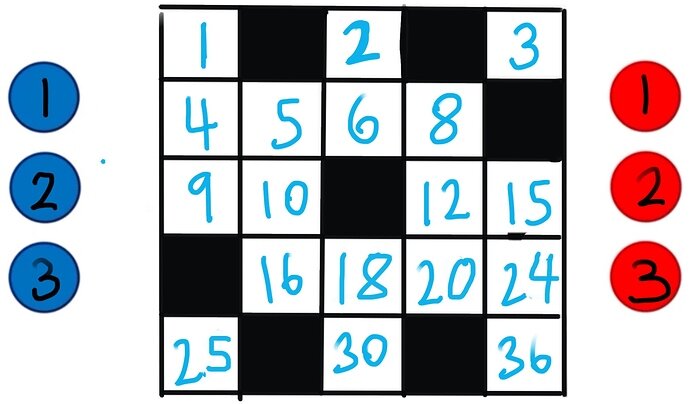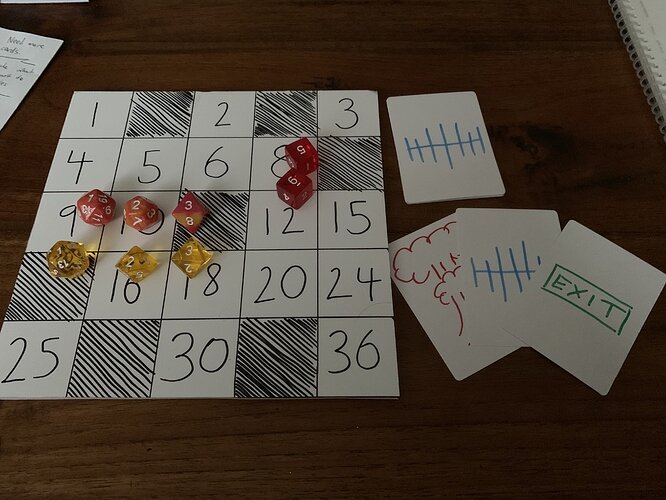After much deliberation, I have executed my grid game, and have come up with the concept of BATTLE BINGO. It’s a mixture of Checkers, Bingo and Rock, Paper, Scissors. My board layout takes the standard grid and puts numbers on it, seemingly at random, to replicate a Bingo card. I hope I have explained the rules sufficiently.
Battle Bingo!
Battle Bingo is the exciting two player game of luck and tactics! In this game, players play the same bingo card, with dice announcing what the numbers are that you put your tokens on, but land on another persons token and it quickly becomes a tactical card game of move and countermove.
Battle Bingo is played in two full rounds where each player gets to play all his pieces, alternatively with his opposition, before a new round begins.
This game would come with a board, two six sided dice, six tokens (three in Blue and three in red, and each colour number 1, 2 and 3) and a deck of 9 cards with images of Teeth (Bite Down), an Arrow (Breakout) and an explosion (Blowup) (3 Of each).
Turn order
-
Draw cards up to a total of three.
-
Player 1 rolls two dice, multiplying the two numbers and placing one of his pieces on the card at the resulting number.
-
Player 2 rolls two dice, and places their piece on the board. (Pieces are numbers 1 to 3 and are played in order)
-
If player 2’s piece is placed on the same space on the card as player 1, player 1’s token is removed from the game, unless he has a card that will allow him to change the result.
These cards are:
Bite Down- the player who held the place first ‘pushes’ the attacking player onto one of the adjoining eight squares (signified by a set of teeth on the card)
Breakout - the player who held the square initial ‘escapes to an adjoining square (signified by an arrow on the card)
Blowup - not a card used in this particular situation, but this card destroys any token on any of the eight adjoining spaces around the space the player’s piece is on.
-
If any player is ‘pushed’ or choose to go onto a blank space, they finish that turn with that piece, and gain an extra card in their hand for the rest of the turn. Also if a player is pushed off the board, they have lost their piece.
-
The play continues until each player has played all his pieces, and all combat resolved.
-
Any cards more than three are disposed of and the turn finished.
Example of play:
P1 rolls two dice, multiplies the result and gets a total of 8. P1 places their piece numbered ‘1’ on to the place marked 8, and his turn finishes.
P2 rolls two dice and coincidentally, rolls an 8 as well. He places his piece numbered ‘1’ on top of P1’s piece on the place marked 8 and before taking the piece, gives P1 an opportunity to play a card.
P1 has 2 Breakout cards in his hand, and a Blowup card, and decides to play a Breakout card, allowing him to escape to a space of his choice on adjacent to the space he was on.
P2 has in his hand a Blowup card, a Breakout card and a Bite Down card. He decides to play the ‘Blowup’ card which destroys and piece on the board adjacent to the square he is on. P1 now has an opportunity to play a card, or lose his piece.
His opportunities in this case are play another Breakout card, and move another space further away, or a Blowup card, which won’t save him, but potentially could destroy P2’s piece as well, and he decides to take this option.
P2 still has a Breakout and a Bite Down card, and he can play either: the Bite Down will shield him from the explosion, and the Breakout card will allow him to escape to another square. He picks Bite Down, and P1’s piece is removed from play
The P1 now rolls the dice and plays his piece numbered ‘2’ and play goes on.
Each player goes into the second part of the round with only one card each left (P1 has a Breakout, and P2 has a Breakout card), and they don’t get to pick a new hand of cards until all three pieces each have been played, or they land on a blank place and can draw a new card.

 At first, when thinking of Bingo, I thought the goal was to form a pattern on the board. But the explanation helped me visualize the game.
At first, when thinking of Bingo, I thought the goal was to form a pattern on the board. But the explanation helped me visualize the game.

